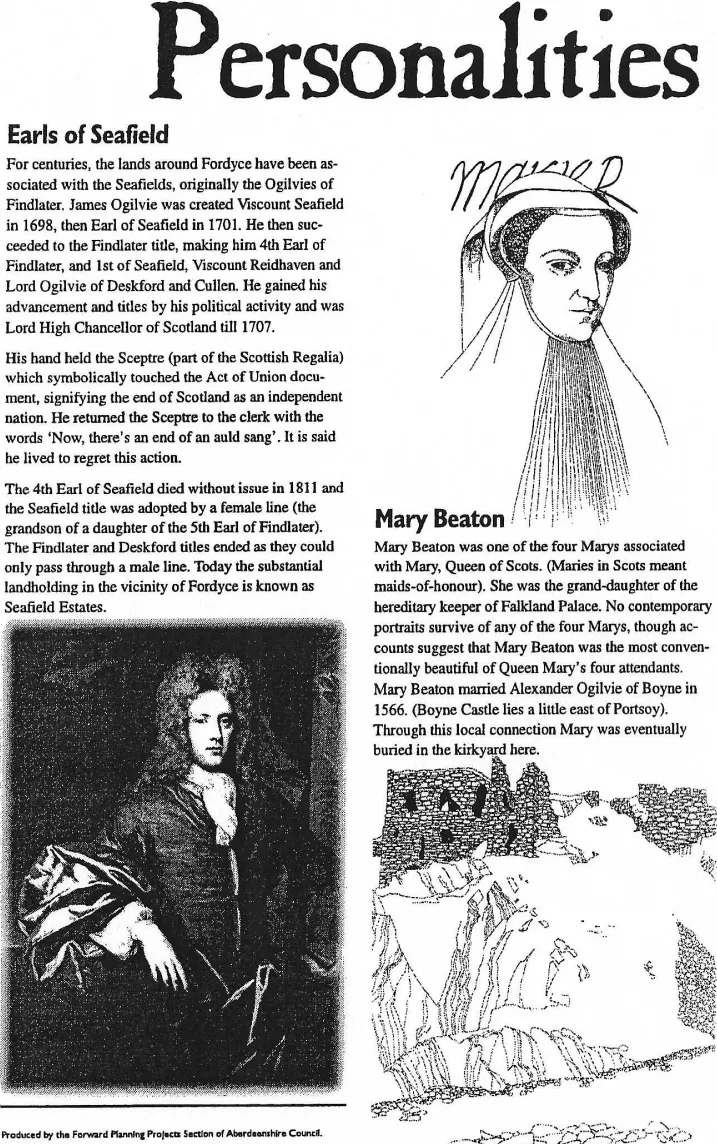Historical Characters
Earls of Seafield
For centuries, the lands around Fordyce have been associated with the Seafields, originally the Ogilvies of Findlater. James Ogilvie was created Viscount Seafield in 1698, then Earl of Seafield in 1701. He then succeeded to the Findlater title, making him 4th Earl of Findlater, and 1st of Seafield, Viscount Reidhaven and Lord Ogilvie of Deskford and Cullen. He gained his advancement and titles by his political activity and was Lord High Chancellor of Scotland till 1707.
His hand held the Sceptre (part of the Scottish Regalia) which symbolically touched the Act of Union document, signifying the end of Scotland as an independent nation. He returned the Sceptre to the clerk with the words “Now, there’s an end of an auld sang.” It is said he lived to regret this action.
The 4th Earl of Seafield died without issue in 1811 and the Seafield title was adopted by a female line (the grandson of a daughter of the 5th Earl of Findlater). The Findlater and Deskford titles ended as they could only pass through a male line. Today the substantial landholding in the vicinity of Fordyce is known as Seafield Estates.
Mary Beaton
Mary Beaton was one of the four Marys associated with Mary, Queen of Scots. (Maries in Scots meant maids-of-honour). She was the grand-daughter of the hereditary keeper of Falkland Palace. No contemporary portraits survive of any of the four Marys, though accounts suggest that Mary Beaton was the most conventionally beautiful of Queen Mary’s four attendants. Mary Beaton married Alexander Ogilvie of Boyne in 1566. (Boyne Castle lies a little east of Portsoy). Through this local connection Mary was eventually buried in the kirkyard here.

Produced by the Forward Planning Projects Section of Aberdeenshire Council.
Thomas Glover
Thomas Glover, 1838-1911, is (as yet) little known in his homeland, but is famous in Japan. He is credited with introducing Japan to western technology, particularly in shipbuilding, and is sometimes described as the father of the Japanese navy. While operating as a business agent (for the famous Jardine, Mathieson & Co) in Japan he ordered the country’s first slip dock. This greatly helped the development of the multi-national company Mitsubishi. In fact, Glover was a trusted adviser and friend of Mitsubishi’s founder, Yataro Iwasaki.
Glover was also responsible for importing Japan’s first steam locomotive and also the first telegraph line. He became involved with the rebel clans in the Japanese revolution in the 1860s which unseated the last Shogun and brought about a western style democracy as well as the restoration of the Emperor. Several incidents in his life are said to have inspired Puccini’s opera ‘Madame Butterfly’.
Glover’s mother, Mary Findlay, was born in Fordyce Parish in 1807. Glover’s father was an officer in the Coastguard with responsibility for the local coast. The couple married in Fordyce Church in 1829 and lived in Sandend. Three of Thomas Glover’s brothers were also born in Fordyce before Thomas’s father’s coastguard duties took the family elsewhere in the North-East.
Sir John Gordon & Findlater Castle
Sir John Gordon, 3rd son of the 4th Earl of Huntly, had been named by Ogilvie of Findlater as the inheritor of Findlater Castle instead of Ogilvie’s son (because of false accusations by Ogilvie’s second wife). His son, James Ogilvie of Cardell, was Master of the household in the court of Mary, Queen of Scots. Mary pursued the matter of the unjust inheritance on her northern ‘progress’ or journey of 1562. This was an expedition made to quell the power of the Gordon family. She visited Findlater but Sir John refused her entry. Later, after the defeat of the Gordons at the Battle of Corrichie, the castle was returned to Ogilvie hands.
George Smith, the great benefactor
George Smith, 1737-1790, a native of Fordyce, went to India and made his fortune. He died on a voyage back to Scotland. In his will he left a substantial amount to be used to found an academy at Fordyce. The money was used to pay the schoolmaster and provide a bursary to allow the teaching of as many boys of the name Smith as funds permit: ‘a yearly allowance of £25 to each boy, desiring and directing that the children of my sisters and their issue to the 4th generation of what name soever may be admitted and partake of this bounty if they desire it and prove their right’. This was duly in place by 1801 with the annual sum covering board, clothing and education. One of his sisters had married a Swede and four generations of Swedish pupils took advantage of the available funds and were educated in Fordyce.
Fordyce and Balmoral Castle
Of the many famous medical men who were educated at Fordyce, perhaps the best known is Cullen-born Sir James Clark ( 1788-1870). He was appointed physician-in-ordinary to Queen Victoria in 1837. In September 1847, the Queen holidayed at Ardverikie on the shores of Loch Laggan west of Dalwhinnie. The weather was persistently awful. Simultaneously, at Balmoral, then owned by Sir Robert Gordon, Sir James’s son was enjoying day after day of sunshine while recuperating from an illness. When Sir James heard of this, he strongly recommended that the Royals consider the benefits of their Scottish retreat. By chance, in October of the same year, Sir Robert Gordon choked on a fishbone and died (without issue), giving up and inheritance to Albert and Victoria. They at first leased then later bought the Balmoral estate, thanks to the advice of their Fordyce-educated physician.
Another Fordyce pupil, Sir John Forbes, likewise attained high office in Royal circles, and was also noted as the first doctor in the UK to advocate the use of the stethoscope.
